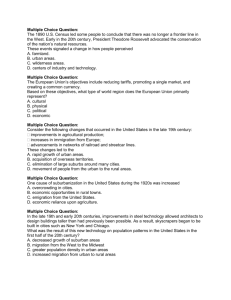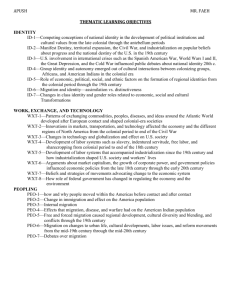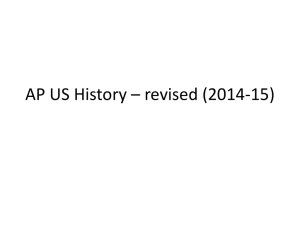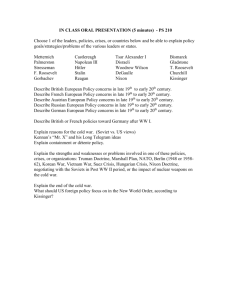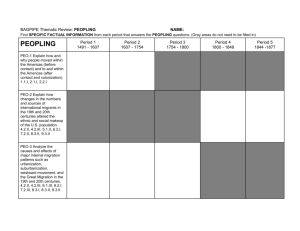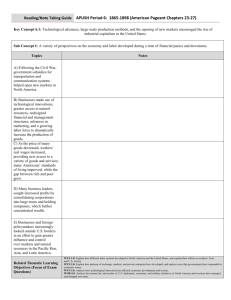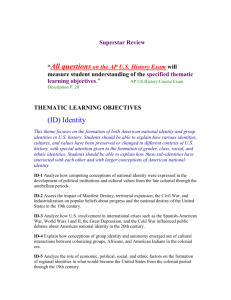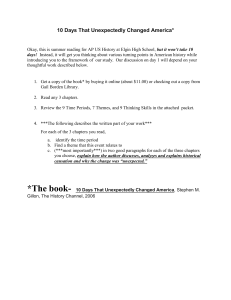Period 6 Content Outline
advertisement
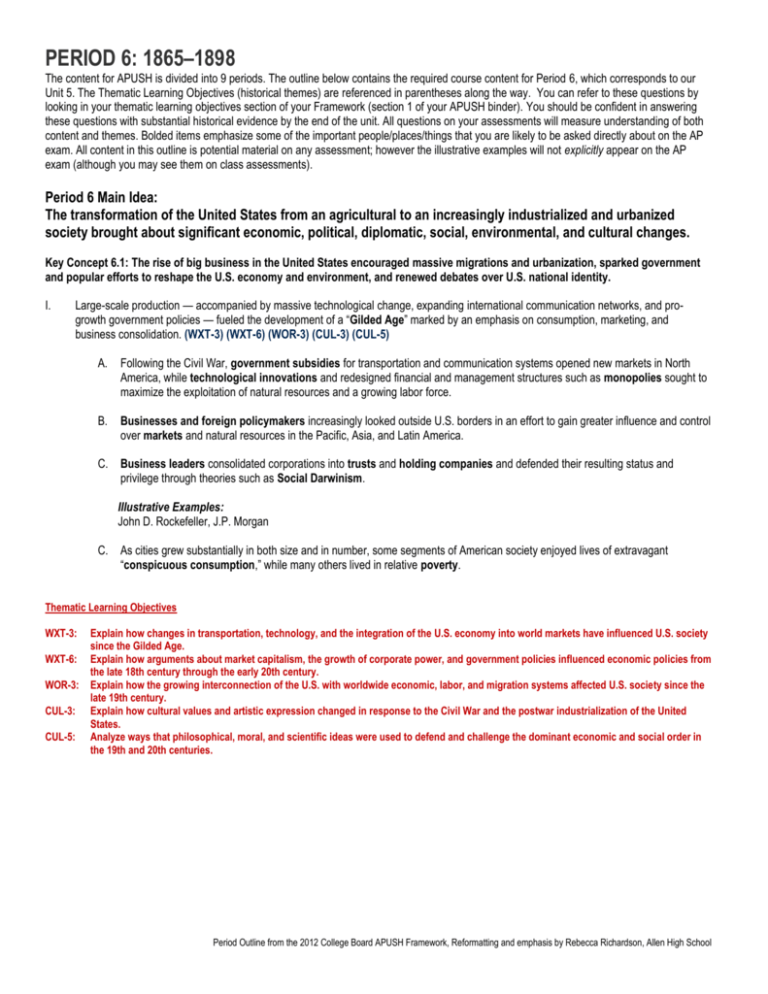
PERIOD 6: 1865–1898 The content for APUSH is divided into 9 periods. The outline below contains the required course content for Period 6, which corresponds to our Unit 5. The Thematic Learning Objectives (historical themes) are referenced in parentheses along the way. You can refer to these questions by looking in your thematic learning objectives section of your Framework (section 1 of your APUSH binder). You should be confident in answering these questions with substantial historical evidence by the end of the unit. All questions on your assessments will measure understanding of both content and themes. Bolded items emphasize some of the important people/places/things that you are likely to be asked directly about on the AP exam. All content in this outline is potential material on any assessment; however the illustrative examples will not explicitly appear on the AP exam (although you may see them on class assessments). Period 6 Main Idea: The transformation of the United States from an agricultural to an increasingly industrialized and urbanized society brought about significant economic, political, diplomatic, social, environmental, and cultural changes. Key Concept 6.1: The rise of big business in the United States encouraged massive migrations and urbanization, sparked government and popular efforts to reshape the U.S. economy and environment, and renewed debates over U.S. national identity. I. Large-scale production — accompanied by massive technological change, expanding international communication networks, and progrowth government policies — fueled the development of a “Gilded Age” marked by an emphasis on consumption, marketing, and business consolidation. (WXT-3) (WXT-6) (WOR-3) (CUL-3) (CUL-5) A. Following the Civil War, government subsidies for transportation and communication systems opened new markets in North America, while technological innovations and redesigned financial and management structures such as monopolies sought to maximize the exploitation of natural resources and a growing labor force. B. Businesses and foreign policymakers increasingly looked outside U.S. borders in an effort to gain greater influence and control over markets and natural resources in the Pacific, Asia, and Latin America. C. Business leaders consolidated corporations into trusts and holding companies and defended their resulting status and privilege through theories such as Social Darwinism. Illustrative Examples: John D. Rockefeller, J.P. Morgan C. As cities grew substantially in both size and in number, some segments of American society enjoyed lives of extravagant “conspicuous consumption,” while many others lived in relative poverty. Thematic Learning Objectives WXT-3: WXT-6: WOR-3: CUL-3: CUL-5: Explain how changes in transportation, technology, and the integration of the U.S. economy into world markets have influenced U.S. society since the Gilded Age. Explain how arguments about market capitalism, the growth of corporate power, and government policies influenced economic policies from the late 18th century through the early 20th century. Explain how the growing interconnection of the U.S. with worldwide economic, labor, and migration systems affected U.S. society since the late 19th century. Explain how cultural values and artistic expression changed in response to the Civil War and the postwar industrialization of the United States. Analyze ways that philosophical, moral, and scientific ideas were used to defend and challenge the dominant economic and social order in the 19th and 20th centuries. Period Outline from the 2012 College Board APUSH Framework, Reformatting and emphasis by Rebecca Richardson, Allen High School II. As leaders of big business and their allies in government aimed to create a unified industrialized nation, they were challenged in different ways by demographic issues, regional differences, and labor movements. (WXT-5) (WXT-6) (WXT-7) (PEO-6) (ID-5) A. The industrial workforce expanded through migration across national borders and internal migration, leading to a more diverse workforce, lower wages, and an increase in child labor. B. Labor and management battled for control over wages and working conditions, with workers organizing local and national unions and/or directly confronting corporate power. Illustrative Examples: Knights of Labor, American Federation of Labor, Mother Jones B. Despite the industrialization of some segments of the southern economy, a change promoted by southern leaders who called for a “New South,” agrarian sharecropping, and tenant farming systems continued to dominate the region. Thematic Learning Objectives WXT-5: WXT-6: WXT-7: PEO-6: ID-5: Explain how and why different labor systems have developed, persisted, and changed since 1800 and how events such as the Civil War and industrialization shaped U.S. society and workers’ lives. Explain how arguments about market capitalism, the growth of corporate power, and government policies influenced economic policies from the late 18th century through the early 20th century Compare the beliefs and strategies of movements advocating changes to the U.S. economic system since industrialization, Particularly the organized labor, Populist, and Progressive movements. Analyze the role of both internal and international migration on changes to urban life, cultural developments, labor issues, and reform movements from the mid-19th century through the mid-20th century Analyze the role of economic, political, social, and ethnic factors on the formation of regional identities in what would become the United States from the colonial period through the 19th century. III. Westward migration, new systems of farming and transportation, and economic instability led to political and popular conflicts. (ENV-5) (WXT-5) (WXT-7) (POL-3) (PEO-3) (PEO-5) A. Government agencies and conservationist organizations contended with corporate interests about the extension of public control over natural resources, including land and water. Illustrative Examples: U.S. Fish Commission, Sierra Club, Department of the Interior B. Farmers adapted to the new realities of mechanized agriculture and dependence on the evolving railroad system by creating local and regional organizations that sought to resist corporate control of agricultural markets. Illustrative Examples: the Grange, Las Gorras Blancas, Colored Farmers’ Alliance C. The growth of corporate power in agriculture and economic instability in the farming sector inspired activists to create the People’s (Populist) Party, which called for political reform and a stronger governmental role in the American economic system. D. Business interests battled conservationists as the latter sought to protect sections of unspoiled wilderness through the establishment of national parks and other conservationist and preservationist measures. Thematic Learning Objectives ENV-5: WXT-5: WXT-7: POL-3: PEO-3: PEO-5: Explain how and why debates about and policies concerning the use of natural resources and the environment more generally have changed since the late 19th century . Explain how and why different labor systems have developed, persisted, and changed since 1800 and how events such as the Civil War and industrialization shaped U.S. society and workers’ lives . Compare the beliefs and strategies of movements advocating changes to the U.S. economic system since industrialization, particularly the organized labor, Populist, and Progressive movements . Explain how activist groups and reform movements, such as antebellum reformers, civil rights activists, and social conservatives, have caused changes to state institutions and U.S. society . Analyze the causes and effects of major internal migration patterns such as urbanization, suburbanization, westward movement, and the Great Migration in the 19th and 20th centuries . Explain how free and forced migration to and within different parts of North America caused regional development, cultural diversity and blending, and political and social conflicts through the 19th century. Period Outline from the 2012 College Board APUSH Framework, Reformatting and emphasis by Rebecca Richardson, Allen High School Key Concept 6.2: The emergence of an industrial culture in the United States led to both greater opportunities for, and restrictions on, immigrants, minorities, and women. I. International and internal migrations increased both urban and rural populations, but gender, racial, ethnic, religious, and socioeconomic inequalities abounded, inspiring some reformers to attempt to address these inequities. (ID-6) (PEO-2) (PEO-3) (PEO-6) (POL-3) A. Increased migrations from Asia and from southern and eastern Europe, as well as African American migrations within and out of the South, accompanied the mass movement of people into the nation’s cities and the rural and boomtown areas of the West. B. Cities dramatically reflected divided social conditions among classes, races, ethnicities, and cultures, but presented economic opportunities as factories and new businesses proliferated. C. Immigrants sought both to “Americanize” and to maintain their unique identities; along with others, such as some African Americans and women, they were able to take advantage of new career opportunities even in the face of widespread social prejudices. D. In a urban atmosphere where the access to power was unequally distributed, political machines provided social services in exchange for political support, settlement houses helped immigrants adapt to the new language and customs, and women’s clubs and self-help groups targeted intellectual development and social and political reform. Illustrative Examples: NAWSA, WCTU Thematic Learning Objectives ID-6: Analyze how migration patterns to, and migration within, the United States have influenced the growth of racial and ethnic identities and conflicts over ethnic assimilation and distinctiveness . PEO-2: Explain how changes in the numbers and sources of international migrants in the 19th and 20th centuries altered the ethnic and social makeup of the U.S. population . PEO-3: Analyze the causes and effects of major internal migration patterns such as urbanization, suburbanization, westward movement, and the Great Migration in the 19th and 20th centuries . PEO-6: Analyze the role of both internal and international migration on changes to urban life, cultural developments, labor issues, and reform movements from the mid-19th century through the mid-20th century . POL-3: Explain how activist groups and reform movements, such as antebellum reformers, civil rights activists, and social conservatives, have caused changes to state institutions and U.S. society. II. As transcontinental railroads were completed, bringing more settlers west, U.S. military actions, the destruction of the buffalo, the confinement of American Indians to reservations, and assimilationist policies reduced the number of American Indians and threatened native culture and identity. (PEO-4) (ENV-5) (POL-6) A. Post–Civil War migration to the American West, encouraged by economic opportunities and government policies, caused the federal government to violate treaties with American Indian nations in order to expand the amount of land available to settlers. Illustrative Examples: subsidies, land-grant colleges B. The competition for land in the West among white settlers, Indians, and Mexican Americans led to an increase in violent conflict. C. The U.S. government generally responded to American Indian resistance with military force, eventually dispersing tribes onto small reservations and hoping to end American Indian tribal identities through assimilation. Illustrative Examples: Dawes Act, Chief Joseph, Ghost Dance movement Thematic Learning Objectives PEO-4: Analyze the effects that migration, disease, and warfare had on the American Indian population after contact with Europeans . ENV-5: Explain how and why debates about and policies concerning the use of natural resources and the environment more generally have changed since the late 19th century POL-6: Analyze how debates over political values (such as democracy, freedom, and citizenship) and the extension of American ideals abroad contributed to the ideological clashes and military conflicts of the 19th century and the early 20th century Period Outline from the 2012 College Board APUSH Framework, Reformatting and emphasis by Rebecca Richardson, Allen High School Key Concept 6.3: The “Gilded Age” witnessed new cultural and intellectual movements in tandem with political debates over economic and social policies. I. Gilded Age politics were intimately tied to big business and focused nationally on economic issues — tariffs, currency, corporate expansion, and laissez-faire economic policy — that engendered numerous calls for reform. (POL-6) A. Corruption in government — especially as it related to big business — energized the public to demand increased popular control and reform of local, state, and national governments, ranging from minor changes to major overhauls of the capitalist system. Illustrative Examples: referendum, socialism, Interstate Commerce Act B. Increasingly prominent racist and nativist theories, along with Supreme Court decisions such as Plessy v. Ferguson, were used to justify violence, as well as local and national policies of discrimination and segregation. Illustrative Examples: American Protective Association, Chinese Exclusion Act Thematic Learning Objective POL-6: Analyze how debates over political values (such as democracy, freedom, and citizenship) and the extension of American ideals abroad contributed to the ideological clashes and military conflicts of the 19th century and the early 20th century. II. New cultural and intellectual movements both buttressed and challenged the social order of the Gilded Age. (ID-2) (CUL-3) (CUL-5) (CUL-6) A. Cultural and intellectual arguments justified the success of those at the top of the socioeconomic structure as both appropriate and inevitable, even as some leaders argued that the wealthy had some obligation to help the less fortunate. Illustrative Examples: Henry George, Edward Bellamy, Gospel of Wealth B. A number of critics challenged the dominant corporate ethic in the United States and sometimes capitalism itself, offering alternate visions of the good society through utopianism and the Social Gospel. C. Challenging their prescribed “place,” women and African American activists articulated alternative visions of political, social, and economic equality. Illustrative Examples: Booker T. Washington, Ida Wells-Barnett, Elizabeth Cady Stanton Thematic Learning Objectives ID-2: CUL-3: CUL-6: Assess the impact of Manifest Destiny, territorial expansion, the Civil War, and industrialization on popular beliefs about progress and the national destiny of the U.S. in the 19th century. Explain how cultural values and artistic expression changed in response to the Civil War and the postwar industrialization of the United States CUL-5: Analyze ways that philosophical, moral, and scientific ideas were used to defend and challenge the dominant economic and social order in the 19th and 20th centuries. Analyze the role of culture and the arts in 19th- and 20th-century movements for social and political change. Period Outline from the 2012 College Board APUSH Framework, Reformatting and emphasis by Rebecca Richardson, Allen High School
